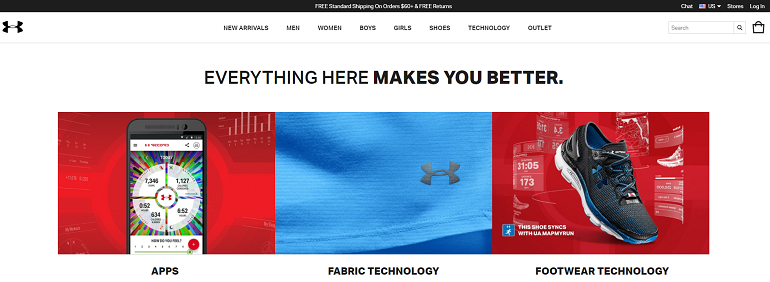Under Armour cites change management woes with SAP implementation as digital transformation stumbles

Digital transformation isn't easy and while the term is sexy companies can't forget the old-school items like change management. Just ask Under Armour, which delivered a clunker of a third quarter and blamed retail bankruptcy, changing consumer tastes, e-commerce and a rough SAP enterprise relationship management implementation as reasons for its shortfall.
To be sure, Under Armour is facing a bevy of challenges. Under Armour needs to be more digital, leverage real-time analytics and keep up with faster rivals such as Adidas, which has embraced fast fashion techniques. Nike has also had its challenges, but has more scale than Under Armour. To navigate these challenges, Under Armour has bet heavily on SAP and become one of the software giant's best-known customers.
But Under Armour executives noted that they've struggled with change management involved with the SAP implementation and missed orders. These orders slipped from the third quarter to the fourth quarter, but now Under Armour's inventory is bloated.
Also: What is DevOps? An executive guide to agile development and IT operations
Under Armour delivered third quarter earnings of $54 million, or 12 cents a share, on revenue of $1.4 billion, down 5 percent from a year ago. Non-GAAP earnings for the third quarter were 22 cents a share. Wall Street was expecting non-GAAP third quarter earnings of 19 cents a share on revenue of $1.48 billion. The company also cut its outlook for earnings and revenue for 2017. Under Armour is projecting 2017 adjusted earnings of 18 cents a share to 20 cents a share relative to the 37 cents a share expected by Wall Street.
Related: Under Armour at CES highlights digital transformation efforts as clothing, wearables, apps, data merge | How Under Armour handles PII on a global scale | Will Under Armour's big data, app experiment pay off?
While Under Armour has a bevy of new challenges, change management is an old one. Patrik Frisk, president and chief operating officer of the company, said on a conference call:
We're also executing on our restructuring plan to narrow our focus and shift our prioritization into areas with the highest opportunity for growth and profitable returns. And we have implemented systems upgrades, including the July 1 launch of our integrated ERP business solution. This includes our point of sale, warehouse management, inventory control, merchandising and product allocation systems in both North America and Europe.
And while these enhancements are designed to enable us to more effectively and efficiently operate our business and, ultimately, enhance productivity for the long term, the implementation caused disruption in our supply chain operations during the quarter. This led to delayed shipments and loss of productivity, which negatively impacted our third quarter results. During this system migration, we have encountered a number of change management issues impacting our workforce and manufacturing partners as they adapt to the new platform and processes.
That said, while this is a key factor impacting our fourth quarter and full year outlook, we're seeing improvements through our service levels and expect them to begin to normalize through the balance of the year.

Frisk added that Under Armour is working to "protect the brand" by managing inventory better and pivot to a direct-to-consumer model. Indeed, Under Armour's inventory was up 22 percent in the third quarter to $1.2 billion. Frisk blamed those inventory levels and operational challenges on the ERP implementation.
How to turn down bad IT ideas at work - without upsetting your colleagues | Enterprise architecture and business planning: now joined at the hip | TechRepublic: How project teams can improve QA testing | Scrum agile project management: The smart person's guide
Where does Under Armour stand with the SAP implementation today? David Bergman, CFO of Under Armour, outlined the following to analysts.
So the SAP implementation, there are a couple different pieces to it that we've been working through. I think one of the aspects was the change management that's been a little bit tougher than we expected, including working even with our inventory partners, our vendors, trying to get them up and trained on the system as well and just getting all the things in place. So right now, the system is operating well. It's stable. But the change management and the learnings and the reporting is what we're still working through here. We expect that in Q4, we won't have the same level of impact that we had in Q3, but (the issues) won't be completely gone yet. We'll continue to work through it and then continue to fine tune as we move into 2018.
Now you can't blame all Under Armour's woes on operations and ERP. Expansion into footwear and digital apps haven't delivered the results expected. Under Armour is also struggling with athleisure clothing. Under Armour has what CEO Kevin Plank calls a "pull problem." Under Armour has a good following--especially among youth--and is known for performance, but the company has struggled to stoke demand. Plank said Under Armour needs to market better and "entice the consumer to ensure that they're desiring the Under Armour brand."
Bottom line: Digital transformation isn't easy--especially when things like change management is fumbled. Evercore analyst Omar Saad summed up Under Armour's situation well:
While Under Armour remains one of the world's few authentic performance brands, an extremely valuable position in the global athletic oligopoly, its traditional channels, markets, and core product categories are transforming faster than the company has been able to evolve.
More digital transformation:
- Comcast: How AI, machine learning, DevOps, and a bit of hardware may make it a smart home platform
- The enterprise technologies to watch in 2017
- Intro: Digital Transformation, a CXO's Guide
- Artificial intelligence, analytics help speed up digital workplace transformation
- Five emerging technologies for rapid digital transformation
- Maker of Taser weapons goes digital, renames itself Axon in cloud platform bet
- Digital transformation: Retooling business for a new ag